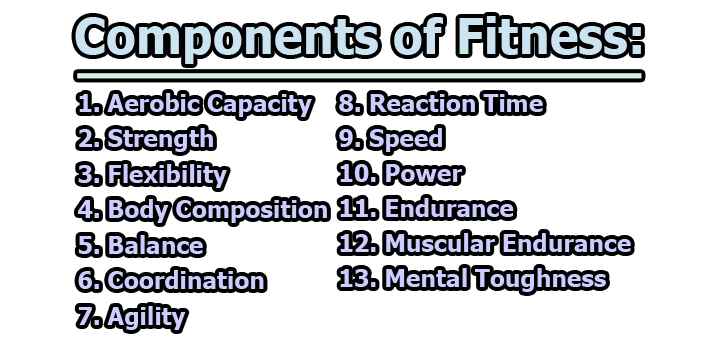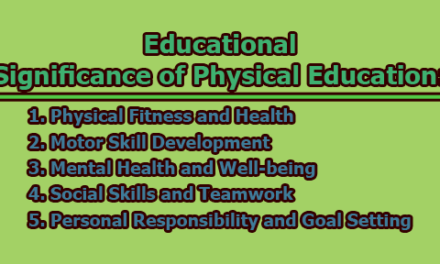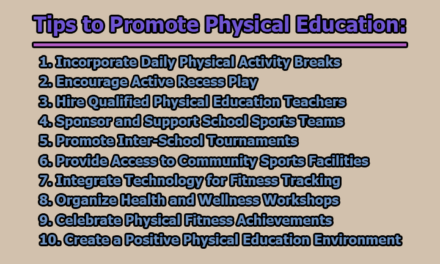Components of Fitness:
Physical fitness is a multi-dimensional concept that encompasses various aspects of an individual’s health and well-being. These components of fitness play a crucial role in determining an individual’s overall physical capability and can significantly impact their quality of life. In this article, we will delve into the various components of fitness, including aerobic capacity, strength, flexibility, body composition, balance, coordination, agility, reaction time, speed, and more. Understanding these components is essential for anyone striving to achieve and maintain a high level of physical fitness and overall health.
1. Aerobic Capacity: Aerobic capacity, also known as cardiovascular fitness or endurance, refers to the ability of the heart, lungs, and circulatory system to supply oxygen to the muscles during sustained physical activity. It is one of the most critical components of fitness and plays a vital role in overall health and performance. Aerobic capacity can be measured through various assessments, including:
a) VO2 Max: This is the maximum amount of oxygen a person can utilize during intense exercise. It is often used as a gold standard for measuring aerobic capacity.
b) Submaximal Tests: These tests estimate VO2 max by monitoring heart rate response to submaximal exercise, such as a treadmill or cycle ergometer test.
c) 1.5-Mile Run Test: A simple field test that assesses aerobic capacity by measuring the time it takes to run 1.5 miles.
Improving aerobic capacity involves engaging in activities like running, swimming, cycling, or brisk walking. Regular aerobic exercise helps strengthen the heart, increase lung capacity, and enhance the body’s ability to transport and utilize oxygen, resulting in improved endurance and overall fitness.
2. Strength: Strength is the ability of muscles to generate force against resistance. It is a fundamental component of fitness and is essential for various activities of daily living, as well as sports performance. Strength can be categorized into different types:
a) Muscular Endurance: The ability of muscles to exert force repeatedly over an extended period.
b) Muscular Power: The ability to generate force quickly, combining strength and speed.
c) Absolute Strength: The maximum amount of force a muscle or group of muscles can generate in a single effort.
d) Relative Strength: Strength relative to body weight, often used in sports like gymnastics or weightlifting.
Strength training exercises, such as weightlifting, resistance training, and bodyweight exercises, help improve muscle strength and endurance. Benefits of increased strength include better posture, reduced risk of injury, and enhanced athletic performance.
3. Flexibility: Flexibility refers to the range of motion around a joint or series of joints. It is a crucial component of fitness as it influences the body’s ability to move freely and perform various activities without strain or discomfort. Benefits of flexibility include:
a) Injury Prevention: Maintaining good flexibility can reduce the risk of muscle strains and joint injuries.
b) Improved Posture: Good flexibility can enhance posture and reduce the risk of musculoskeletal problems.
c) Enhanced Performance: In sports and daily activities, increased flexibility can improve movement efficiency.
Stretching exercises, including static stretching, dynamic stretching, and yoga, are effective ways to improve flexibility. Regular stretching routines can help increase joint mobility, reduce muscle tension, and improve overall flexibility.
4. Body Composition: Body composition refers to the proportion of lean mass (muscles, bones, organs) to fat mass in the body. It is a critical component of fitness, as it can directly impact an individual’s health and well-being. There are several methods to assess body composition, including:
a) Body Mass Index (BMI): A simple calculation using weight and height to estimate body composition. However, it doesn’t differentiate between muscle and fat.
b) Dual-energy X-ray Absorptiometry (DXA): A precise method that measures bone density, lean tissue, and fat mass.
c) Bioelectrical Impedance Analysis (BIA): Measures the resistance of electrical flow through body tissues to estimate body fat percentage.
d) Skinfold Caliper Measurements: Involves measuring skinfold thickness at specific sites to estimate body fat percentage.
Maintaining a healthy body composition, characterized by a higher proportion of lean muscle mass and a lower percentage of body fat, is associated with improved overall health, reduced risk of chronic diseases, and enhanced physical performance. Achieving and maintaining a healthy body composition requires a combination of regular physical activity and a balanced diet.
5. Balance: Balance is the ability to maintain equilibrium and control the body’s position during various activities, whether stationary or in motion. It is crucial for stability and injury prevention in everyday life and sports. Balance can be categorized into two types:
a) Static Balance: The ability to maintain equilibrium while stationary, such as standing on one leg.
b) Dynamic Balance: The ability to maintain equilibrium while in motion, such as when walking or running.
Improving balance can enhance coordination, reduce the risk of falls, and enhance sports performance. Balance training exercises, such as standing on one leg, stability ball exercises, and yoga poses, can help develop this important component of fitness.
6. Coordination: Coordination is the ability to integrate different body parts smoothly and efficiently to perform a specific task or movement accurately. It involves the synchronization of muscles, joints, and sensory information from the nervous system. Coordination can be broken down into several components:
a) Hand-Eye Coordination: The ability to coordinate visual input with manual movements, crucial in sports like tennis or basketball.
b) Gross Motor Coordination: Involves the coordination of large muscle groups for movements like running or jumping.
c) Fine Motor Coordination: Involves precise control of smaller muscle groups, often seen in tasks requiring dexterity, such as playing a musical instrument.
Improving coordination requires practice and can be developed through activities like sports, dance, martial arts, and fine motor skill exercises. Enhanced coordination contributes to better motor skills, agility, and overall physical performance.
7. Agility: Agility is the ability to change direction quickly and efficiently while maintaining control and balance. It is a critical component of fitness for sports that involve rapid changes in direction, such as soccer, basketball, and tennis. Agility training focuses on improving:
a) Speed of Direction Change: The ability to react and change direction promptly.
b) Balance during Rapid Movements: Maintaining stability while moving quickly.
c) Coordination of Limbs: Coordinating multiple movements simultaneously.
Agility drills, cone drills, ladder drills, and sport-specific movements are effective training methods to enhance agility. Improved agility can lead to a competitive edge in sports and reduce the risk of injuries related to quick directional changes.
8. Reaction Time: Reaction time refers to the time it takes for an individual to respond to a specific stimulus or event. It is a critical component of fitness in sports, where quick decision-making and reaction are essential for success. Reaction time can be classified into several categories:
a) Simple Reaction Time: The time it takes to respond to a single stimulus.
b) Choice Reaction Time: The time it takes to react to multiple stimuli, each requiring a different response.
c) Visual Reaction Time: The time it takes to respond to visual stimuli.
d) Auditory Reaction Time: The time it takes to respond to auditory stimuli.
Improving reaction time involves practicing activities that challenge the sensory and motor systems, such as playing sports, video games, or participating in reaction time drills. Enhanced reaction time can lead to better performance in sports and everyday tasks that require quick decision-making.
9. Speed: Speed is the ability to move quickly from one point to another in the shortest amount of time. It is an essential component of fitness in sports that involve sprinting, such as track and field, soccer, and American football. Speed can be divided into different categories:
a) Maximum Speed: The highest velocity an individual can reach in a short burst of effort, typically during a sprint.
b) Acceleration: The rate at which an individual can increase their speed from a standstill.
c) Speed Endurance: The ability to maintain high-speed performance over a more extended period.
d) Reaction Speed: The ability to respond quickly to a specific stimulus, which is closely related to reaction time.
Speed training includes sprinting drills, interval training, and plyometric exercises. Developing speed can lead to improved athletic performance and a competitive advantage in sports that demand rapid acceleration and top-end speed.
10. Power: Power is the combination of strength and speed, reflecting the ability to generate force quickly. It is crucial in sports that require explosive movements, such as weightlifting, sprinting, and jumping. Power can be categorized into:
a) Explosive Power: The ability to exert maximum force in a short duration, such as jumping or throwing.
b) Elastic Power: The ability to use the stretch-shortening cycle of muscles to generate force rapidly.
c) Muscular Power: The combination of strength and speed in a specific movement.
Training for power often involves exercises like plyometrics, Olympic lifting, and explosive bodyweight movements. Developing power can lead to improved athletic performance, particularly in activities that require explosive strength.
11. Endurance: Endurance refers to the ability to sustain physical activity for an extended period without fatigue. It is crucial for activities that involve prolonged effort, such as distance running, cycling, and swimming. Endurance can be classified into two main categories:
a) Cardiovascular Endurance: The ability of the heart and lungs to supply oxygen to the muscles during prolonged exercise.
b) Muscular Endurance: The ability of muscles to maintain force production over an extended duration.
Training for endurance typically involves long-duration, low- to moderate-intensity activities, such as steady-state cardio workouts, long-distance running, or cycling. Developing endurance can lead to improved stamina and the ability to perform sustained physical activities for longer periods.
12. Muscular Endurance: Muscular endurance is the ability of muscles to exert force repeatedly or maintain force production over an extended period without fatigue. It is essential for activities that require sustained muscle effort, such as swimming, rowing, and high-repetition resistance training. Improving muscular endurance involves:
a) High-Repetition Resistance Training: Performing exercises with lighter weights and higher repetitions to build endurance.
b) Circuit Training: Completing a series of exercises with minimal rest in between to challenge multiple muscle groups.
c) Calisthenics: Bodyweight exercises like push-ups, squats, and planks that promote muscular endurance.
Enhanced muscular endurance can lead to improved performance in activities that require repetitive muscle contractions and reduced risk of muscle fatigue during exercise.
13. Mental Toughness: While not a physical component of fitness, mental toughness is a psychological aspect that plays a vital role in an individual’s ability to persevere through challenging physical tasks and achieve their fitness goals. Mental toughness includes attributes such as:
a) Focus: The ability to concentrate on the task at hand, ignoring distractions.
b) Resilience: The capacity to bounce back from setbacks and adversity.
c) Determination: A strong desire to reach one’s goals, even in the face of obstacles.
d) Confidence: Belief in one’s abilities and the ability to perform under pressure.
Mental toughness can be developed through various strategies, including goal setting, visualization, positive self-talk, and exposure to challenging situations. It is a valuable asset for athletes and individuals pursuing fitness goals as it can enhance motivation and performance.
Skill-Related Fitness Components:
In addition to the primary components of fitness discussed above, skill-related fitness components are essential for individuals participating in specific sports and activities. These components focus on specialized skills and abilities required for success in particular disciplines. Skill-related fitness components include:
- Agility: The ability to change direction quickly and efficiently while maintaining control and balance.
- Balance: The ability to maintain equilibrium while stationary or in motion.
- Coordination: The ability to integrate different body parts smoothly and efficiently for precise movements.
- Reaction Time: The ability to respond quickly to specific stimuli.
- Speed: The ability to move quickly from one point to another.
- Power: The combination of strength and speed to generate force rapidly.
Skill-related fitness components are highly sport-specific and depend on the unique demands of each activity. Training for these components often involves drills and exercises tailored to improve the specific skills required in a particular sport or discipline.
Age and Fitness Components:
It is important to recognize that an individual’s fitness components can vary with age. As people age, there may be natural changes in their physical capabilities. However, regular physical activity and exercise can help mitigate the effects of aging on fitness components. Age-related changes in fitness components may include:
- Decreased Muscle Mass: A natural decline in muscle mass with age, known as sarcopenia, can impact strength and power.
- Reduced Flexibility: Joints may become less flexible with age, requiring additional stretching and mobility exercises.
- Cardiovascular Changes: The cardiovascular system may become less efficient with age, making it important to maintain aerobic capacity through regular exercise.
- Balance and Coordination: Age-related changes in sensory perception and neuromuscular function can affect balance and coordination.
- Bone Density: Osteoporosis, a condition characterized by decreased bone density, can increase the risk of fractures, emphasizing the importance of weight-bearing exercises.
While age can influence fitness components, consistent exercise, and a healthy lifestyle can help individuals maintain and improve their physical capabilities throughout their lives.
Individual Variation:
It’s important to note that individuals vary in their genetic predispositions and abilities when it comes to fitness components. Some people may naturally excel in one area, such as strength or speed, while others may have to work harder to develop specific components. Individual variation also extends to how quickly individuals respond to training and how they adapt to different types of exercise. Factors that contribute to individual variation in fitness components include:
- Genetics: Genetic factors can influence an individual’s potential for certain physical attributes, such as muscle mass or aerobic capacity.
- Training History: Prior exercise experience can impact an individual’s baseline fitness level and their ability to progress in specific components.
- Lifestyle: Nutrition, sleep, stress management, and other lifestyle factors can affect an individual’s overall fitness.
- Motivation and Consistency: The level of commitment and consistency in exercise and training plays a significant role in an individual’s fitness progress.
Understanding individual variation is essential when setting fitness goals and expectations. It’s important to focus on personal improvement and progress rather than comparing oneself to others.
Developing a Well-Rounded Fitness Program:
To achieve comprehensive fitness and address all the components discussed, it’s essential to create a well-rounded fitness program that incorporates a variety of exercises and activities. A well-rounded program should consider the following:
- Cardiovascular Exercise: Include aerobic activities like running, cycling, swimming, or dancing to improve aerobic capacity.
- Strength Training: Incorporate resistance exercises using free weights, machines, or bodyweight movements to build strength.
- Flexibility and Mobility: Regularly include stretching and mobility exercises to improve flexibility and joint range of motion.
- Balance and Coordination: Integrate balance drills, stability exercises, and coordination challenges into your routine.
- Skill-Specific Training: If you have specific fitness goals or participate in particular sports, include skill-specific exercises and drills.
- Periodization: Vary the intensity and focus of your training over time to prevent plateaus and continually challenge your body.
- Rest and Recovery: Allow time for rest and recovery to prevent overtraining and reduce the risk of injury.
- Nutrition: Maintain a balanced diet to support your fitness goals and overall health.
- Hydration: Proper hydration is essential for optimal performance and recovery.
- Mental Training: Incorporate mental strategies like visualization and goal setting to enhance motivation and mental toughness.
A well-rounded fitness program should be tailored to individual goals and preferences. Consulting with a fitness professional or personal trainer can help create a customized plan that addresses specific fitness components and targets desired outcomes.
Monitoring Progress:
Monitoring progress is crucial for tracking improvements in fitness components and ensuring that fitness goals are being met. Several methods can be used to monitor progress:
- Fitness Assessments: Regular fitness assessments, including measurements of aerobic capacity, strength, flexibility, and body composition, provide objective data on progress.
- Performance Metrics: Record performance metrics related to your specific fitness goals, such as running times, weight lifted, or skill achievements.
- Training Logs: Maintain a training log to track workouts, including exercises, sets, reps, and weights used. This can help identify trends and adjustments needed in your program.
- Body Measurements: Periodically measure key body metrics, such as waist circumference, to assess changes in body composition.
- Psychological Assessment: Reflect on your mental state, motivation, and attitude toward training to ensure a positive mindset.
- Self-Reflection: Assess how you feel physically and mentally, noting any changes in energy levels, mood, or overall well-being.
Regularly monitoring progress allows for adjustments to your fitness program, ensuring that it remains effective and aligned with your goals.
Common Challenges and Considerations:
While striving to improve fitness components, individuals may encounter common challenges and considerations:
- Plateaus: Progress may stagnate at times, requiring changes to the exercise routine, intensity, or variation.
- Overtraining: Excessive exercise without adequate rest and recovery can lead to overtraining, resulting in fatigue and increased injury risk.
- Injury Prevention: Proper form, warm-up, and cooldowns are essential to minimize the risk of injuries during exercise.
- Nutrition: A balanced diet supports overall fitness, and nutritional choices can influence energy levels and performance.
- Lifestyle Factors: Stress, sleep quality, and other lifestyle factors can impact fitness components.
- Adherence: Staying consistent with a fitness program can be challenging, and maintaining motivation is crucial.
- Individual Goals: Goals should be specific, measurable, achievable, relevant, and time-bound (SMART) to provide clear direction and motivation.
Addressing these challenges and considerations is essential to maintaining a successful and sustainable fitness journey.
In conclusion, achieving comprehensive fitness involves understanding and developing multiple components, including aerobic capacity, strength, flexibility, body composition, balance, coordination, agility, reaction time, speed, and more. These components collectively contribute to an individual’s physical well-being and overall quality of life.
Creating a well-rounded fitness program that incorporates a variety of exercises and activities tailored to individual goals is key to progress. Monitoring progress, adjusting the program as needed, and addressing common challenges and considerations are essential steps in achieving and maintaining a high level of fitness.
Remember that fitness is a dynamic and lifelong journey. Embracing a balanced and sustainable approach to fitness can lead to improved health, enhanced physical capabilities, and a higher quality of life. By prioritizing fitness and committing to regular exercise, individuals can unlock their full potential and enjoy the many benefits of a healthy and active lifestyle.
References:
- American College of Sports Medicine. (2018). ACSM’s Guidelines for Exercise Testing and Prescription. Wolters Kluwer.
- Baechle, T. R., & Earle, R. W. (2008). Essentials of Strength Training and Conditioning. Human Kinetics.
- Fleck, S. J., & Kraemer, W. J. (2014). Designing Resistance Training Programs. Human Kinetics.
- Heyward, V. H. (2010). Advanced Fitness Assessment and Exercise Prescription. Human Kinetics.
- McArdle, W. D., Katch, F. I., & Katch, V. L. (2014). Exercise Physiology: Nutrition, Energy, and Human Performance. Wolters Kluwer.
- Powers, S. K., & Howley, E. T. (2017). Exercise Physiology: Theory and Application to Fitness and Performance. McGraw-Hill Education.
- Wilmore, J. H., & Costill, D. L. (2007). Physiology of Sport and Exercise. Human Kinetics.
- McArdle, W. D., Katch, F. I., & Katch, V. L. (2018). Essentials of Exercise Physiology. Wolters Kluwer.
- Garber, C. E., Blissmer, B., Deschenes, M. R., Franklin, B. A., Lamonte, M. J., Lee, I. M., … & Swain, D. P. (2011). Quantity and quality of exercise for developing and maintaining cardiorespiratory, musculoskeletal, and neuromotor fitness in apparently healthy adults: guidance for prescribing exercise. Medicine & Science in Sports & Exercise, 43(7), 1334-1359.
- National Strength and Conditioning Association. (2016). NSCA’s Essentials of Personal Training. Human Kinetics.

Former Student at Rajshahi University










